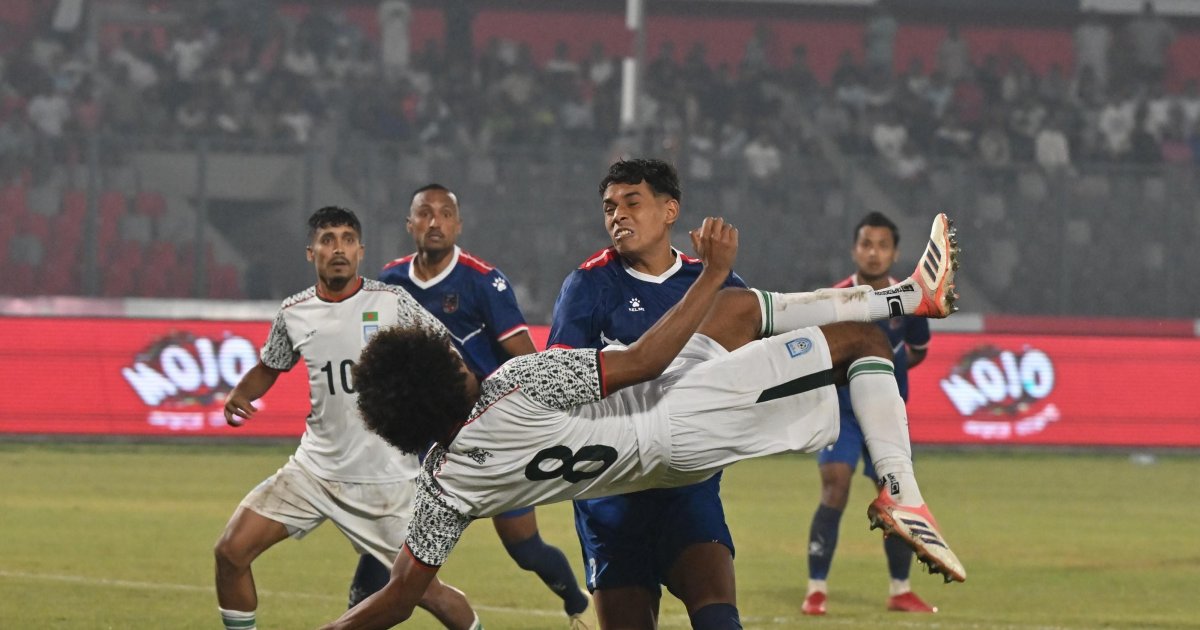Hamza Choudhury scored a bicycle kick against Nepal on Thursday — a moment so rare in Bangladesh’s international football that former players struggled to recall a similar goal in the past.
“If I say in one word, calling it just a wonderful goal would still be less,” former national star striker Zahid Hasan Ameli told Dhaka Tribune about Hamza’s overhead strike in the first minute of the second half. Bangladesh were trailing by a goal before that sensational equalizer arrived.
“It was an exceptional goal. You will see such a goal once or twice in world football,” he added.
“Not everybody has the top-class fitness and ability to score such a goal. One has to understand the measurement and timing of the ball to execute it. Considering everything, it is one of the best goals in an international match for us,” continued Ameli, whose career spanned from 2002 to 2021.
Ameli made his international debut for Bangladesh in 2005 and continued for 11 years. He also represented seven clubs in the domestic league.
“I haven’t seen any Bangladeshi player score a bicycle goal in the last 25 years,” Ameli said.
Goals from bicycle, overhead, or scissor kicks are rare even on the global stage.
The origin of the move remains debated as scholarly opinions vary. According to respected Uruguayan writer Eduardo Galeano, it was first performed in Chile. In his celebrated book Football in Sun and Shadow, Galeano described Spanish-born Chilean Ramón Unzaga’s goal in 1914 during an away match as the earliest documented bicycle kick.
Some South Americans refer to it as a Chalaca, tracing it to Callao, Peru, whose residents are known as “Chalacos”. A local player from Callao reportedly executed the move against British sailors in 1892. FIFA Inside, citing Peruvian historian Jorge Basadre, refers to this version as well. Whether it began in Brazil, Chile, or Peru, most evidence points to South American origins.
Another South American name appears whenever the conversation shifts to bicycle kicks: Brazil’s Leônidas da Silva, who popularized the move in 1938. During the quarter-final of the FIFA World Cup in France, the man known as the “Black Diamond” performed what would become his trademark against Czechoslovakia.
The bicycle kick is also known as an overhead kick or scissor kick. In Italy, it’s called a rovesciata; in Germany, a Fallrückzieher; and in French, a ciseaux retourné, according to FIFA Inside.
Efforts were made to find out whether any Bangladeshi player had scored a bicycle goal for the national team before Hamza, but all former players who responded said there was none. The Bangladesh Football Federation also could not provide any record of such a goal in the national team’s history.
Dhaka Tribune spoke to legendary footballer Kazi Salahuddin, who later coached the national team and served four consecutive terms as President of the Bangladesh Football Federation.
“It was perfectly executed. The timing was perfect. It was a beautiful goal,” Salahuddin said about Hamza’s strike, emphasizing its significance in bringing Bangladesh level.
“Bangladesh players have scored many types of beautiful goals, but not this,” he added.
Another Bangladesh legend, Sheikh Mohammad Aslam — whose domestic and international career spanned nearly two decades — said the same: no national-team player had previously scored a bicycle kick in international football.
“It is one of the best goals so far. It was fantastic. It was made possible because of Hamza,” said the former star striker, who played from the late 1970s to the mid-1990s.
Ashraf Uddin Ahmed Chunnu, the iconic winger of the 1970s and 1980s, summed up Hamza’s goal in simple words: “It was an impossibly beautiful goal.”
It was Hamza’s third goal for Bangladesh — all coming this year since his international debut against India in March. He also scored a rare Panenka penalty four minutes later, but the hosts were denied a win by Nepal’s stoppage-time equalizer.



